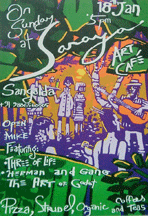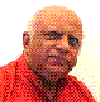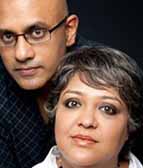The Black Hole of Calcutta was the guard room in the old Fort William, at Calcutta, India where troops of the Nawab of Bengal, Siraj ud-Daulah, held British prisoners of war after the capture of the Fort on June 19, 1756.
John Zephaniah Holwell claimed that following the fall of the fort, British and Anglo-Indian soldiers and civilians were held overnight in conditions so cramped that many died from suffocation, heat exhaustion and crushing. He claimed that 123 prisoners died out of 146 prisoners held. Doubt has been cast on both the numbers alleged and on whether the incident happened at all, and some modern historians have suggested the incident was fabricated by Holwell as a piece of propaganda to blacken the image of Siraj.[1]
Background
Fort William was established to protect British East India Company trade in the city of Calcutta in the region of Bengal. In 1756, with a view to the possibility of conflict with French forces, the British began building up the fort's military strength and defences. The Nawab of Bengal, Siraj ud-Daulah, was unhappy with the company's interference in the internal affairs of his province and perceived a threat to its independence. As ruler he ordered an immediate stop to the fort's military enhancement but the company paid no heed. As a consequence, Siraj organized his army and laid siege to the fort, whose defenders took many casualties. The garrison's commander organised an escape, and left a token force in the fort under the command of John Zephaniah Holwell, a one-time military surgeon who was a top East India Company civil servant. However, desertions by allied troops, mainly Dutch, made even this temporary defence untenable, and the fort was taken.
[edit] The Holwell account
Holwell wrote an account of the incident in which he claimed that of 146 prisoners, 123 suffocated when imprisoned in the tiny room. His version of events, which was not challenged by other survivors, was widely accepted at the time in Britain.
Indian soldiers captured the surviving defenders, who numbered from 64 to 69, as well as an unknown number of Anglo-Indian soldiers and civilians who had been sheltering in the fort. During this period some prisoners were able to escape, and others attacked their guards. According to Holwell, the troops, apparently acting on their own, then packed the prisoners in a guardroom measuring 14 by 18 ft (4.3 by 5.5 m) and locked them in overnight. Prisoners begged for water or escape, growing delirious from heat exhaustion. As time passed, men collapsed from heat stroke, suffocation, or trampling. The prisoners were not released until morning, when Siraj ud-Daulah awoke. By then, certain modern historians believe, some 43 members of the garrison were dead or missing for other reasons.[2] Because so many non-combatants were present in the fort when it fell, the number who died cannot be stated with any precision.[3]
The corpses were thrown into a ditch. Holwell and three others were sent as prisoners to Murshidabad; the rest of the survivors obtained their liberty after the victory of a relief expedition under Robert Clive. The 'Black Hole' was later used as a warehouse, and an obelisk, 50 feet (15 m) high, was erected in memory of the dead.
The following description from a 1911 encyclopedia portrays Holwell's point of view vividly:
- The dungeon was a strongly barred room and was not intended for the confinement of more than two or three men at a time. There were only two windows, and a projecting veranda outside and thick iron bars within impeded the ventilation, while fires raging in different parts of the fort suggested an atmosphere of further oppressiveness. The prisoners were packed so tightly that the door was difficult to close.
- One of the soldiers stationed in the veranda was offered 1,000 rupees to have them removed to a larger room. He went away, but returned saying it was impossible. The bribe was then doubled, and he made a second attempt with a like result; the nawab was asleep, and no one dared wake him.
- By nine o'clock several had died, and many more were delirious. A frantic cry for water now became general, and one of the guards, more compassionate than his fellows, caused some to be brought to the bars, where Mr. Holwell and two or three others received it in their hats, and passed it on to the men behind. In their impatience to secure it nearly all was spilt, and the little they drank seemed only to increase their thirst. Self-control was soon lost; those in remote parts of the room struggled to reach the window, and a fearful tumult ensued, in which the weakest were trampled or pressed to death. They raved, fought, prayed, blasphemed, and many then fell exhausted on the floor, where suffocation put an end to their torments.
- About 11 o'clock the prisoners began to drop off fast. At length, at six in the morning, Siraj-ud-Daulah awoke, and ordered the door to be opened. Of the 146 only 23, including Mr. Holwell (from whose narrative, published in the Annual Register for 1758, this account is partly derived), remained alive, and they were either stupefied or raving. Fresh air soon revived them, and the commander was then taken before the nawab, who expressed no regret for what had occurred, and gave no other sign of sympathy than ordering the Englishman a chair and a glass of water. Notwithstanding this indifference, Mr. Holwell and some others acquit him of any intention of causing the catastrophe, and ascribe it to the malice of certain inferior officers, but many think this opinion unfounded.
[edit] Victims
This is Holwell's actual list of the victims:[4]
"List of the smothered in the Black Hole prison exclusive of sixty-nine, consisting of Dutch and English sergeants, corporals, soldiers, topazes, militia, whites, and Portuguese, (whose names I am unacquainted with), making on the whole one hundred and twenty-three persons.’
Of Council - E. Eyre, Wm. Baillie,. Esqrs., the Rev. Jervas Bellamy.
Gentlemen in the Service-Messrs. Jenks, Revely, Law, Coales, Valicourt, Jeb, Torriano, E. Page, S. Page, Grub, Street, Harod, P. Johnstone, Ballard, N. Drake, Carse, Knapton, Gosling, Bing, Dod, Dalrymple.
Military Captains - Clayton, Buchanan, Witherington.
Lieutenants-Bishop, Ifays, Blagg, Simson, Bellamy.
Ensigns-Paccard, Scot, Hastings, C. Wedderburn, Dumbleton.
Sergeants, &c. - Sergeant-Major Abraham, Quartermaster Cartwright, Sergeant Bleau (these were sergeants of militia).
Sea Captains-Hunt, Osburne, Purnell (survived the night, but died next day), Messrs. Carey, Stephenson, Guy, Porter, W. Parker, Caulker, Bendall, Atkinson, Leech, &c., &c.
List of those who survived - Messrs. Holwell, Court, Secretary Cooke, Lushington, Burdett, Ensign Walcott, Mrs. Carey, Captain Mills, Captain Dickson, Mr. Moran, John Meadows and twelve military and militia, blacks and whites, some of whom recovered when the door was opened."
"Portuguese" was the general, albeit confusing, name used for Calcutta's Anglo-Indians: a term commonly used from the early 18th century to the mid 19th century - but no later than 1850. In 1829 Victor Jacquemont (travelling naturalist, to the Museum of Natural History, Paris) wrote: "There is a fairly large Portuguese population in Calcutta. Few of them, it is true, can boast a purely European origin; there are some, but they are all black, blacker than the natives... " In 1798 ‘Portuguese and other Christian inhabitants’ (IE, Eurasians and Indian converts) occupied 2,650 houses out of a total of 78,760 city abodes. They were often the distant offspring of Portuguese soldiers who had established the first European settlement in Bengal at Hooghly.
[edit] Controversy
Holwell claims that one hundred and twenty-three died of one hundred and forty-six held. While his account was not questioned in Britain at the time, other contemporary accounts claimed a larger number and differed on other details such as the room size and whether there was a window. In 1915, British scholar J.H. Little challenged Holwell's claims in his article, "The 'Black Hole' — The Question of Holwell's Veracity", arguing that Holwell was an unreliable witness and his veracity is questionable. Little went so far as to label Holwell's version "a gigantic hoax". Other historians, including Indian scholar Brijen Gupta, disagreed with Little's strong belief, but nevertheless downplayed Holwell's account.
The following arguments have been listed against Holwell's account:
- Absence of any independent confirmation: It is stated that apart from Holwell's account no other source mentioned such an incident. Given its nature, it seems very unlikely that all traces of such a thing having happened would have disappeared. It must be remembered that the Bengal sultanate was a decaying, bureaucratic one, not at all suited to systematic suppression of information. Historian R C Majumdar in his An Advanced History of India says that Holwell's story is entirely baseless and cannot be considered reliable historical information. However, Secretary Cooke, another alleged European survivor of the Black Hole, gave evidence before the Parliamentary Committee of 1772.[5].
- Little argued that, after the deaths in the occupation of Calcutta and the subsequent evacuation and desertion, 146 British prisoners could not have been left in Siraj's hands three hours after the surrender, though this claim has been challenged. Holwell's list of the alleged victims explicitly includes Anglo-Indians and East India Company sepoys. Aside from the aforementioned list, in his account he writes of being crushed by a fellow inmate who was a "Topaz" (a black Catholic soldier); moreover, the only female survivor, Mrs. Carey, was described as a "country-born" woman, which in the language of the time meant of mixed blood.
- Only forty-three of the garrison were listed as missing from Fort William after the incident and therefore the maximum number of deaths could only be forty-three. However, this is also subject to the objection that according to the Holwell account itself, not all the prisoners would have been listed as members of the garrison.
- Bholanath Chunder, a Bengali landlord, opined that a floor area of 267 square feet (25 m²) could not contain 146 European adults. In order to prove this, Bholanath fenced round an area 15 by 18 feet (4.6 by 5.5 m) with bamboo stalks and counted the number of his Bengali tenants who could be crammed into it. The number was found to be much less than 146, and a Bengali villager's body occupies much less space than a British soldier's. By comparison, modern subway standards specify 3 square feet (0.28 m2) for rush-hour standees, 146 people in the 'Black Hole' would have had about 1.85 square feet (0.172 m2). However, this objection misses the point that the prisoners in the 'hole' were so cramped that they perished, and subway densities are designed to give enough space to prevent this.
The true number of deaths will probably never be definitively established. No list was made of the British soldiers surrendering at the fort, not even a count of heads. Many escaped between the surrender and the alleged confinement in the 'Black Hole'. Even Holwell was offered by a friend the chance to escape. Therefore, the number of deaths in the 'Black Hole' could have been considerably fewer.
Historian Simon Schama suggested on his 'A History of Britain' programme, which aired in September 2000, that Holwell exaggerated the exact number of people by about three times its actual amount.
[edit] The monument
Holwell had erected a tablet on the site of the 'Black Hole' to commemorate the victims but, at some point before 1822 (the precise date is uncertain), it disappeared. Lord Curzon, on becoming Viceroy in 1899, noticed that there was nothing to mark the spot and commissioned a new monument, mentioning the prior existence of Holwell's; it was erected in 1901 at the corner of Dalhousie Square, which is said to be the site of the 'Black Hole'.[6] At the apex of the Indian independence movement, the presence of this monument in Calcutta was turned into a nationalist cause celebre. Nationalist leaders like Subhash Chandra Bose lobbied energetically for its removal. The Congress and the Muslim League joined forces in the anti-monument movement. As a result, Abdul Wasek Mia of Nawabganj thana (now in Bangladesh), a student leader of that time led the removal of the monument from Dalhousie Square in July, 1940. The monument was re-erected in the graveyard of St John's Church, where it remains to this day.
The 'Black Hole' itself, being merely the guardroom in the old Fort William, disappeared shortly after the incident when the fort itself was taken down to be replaced by the new Fort William which still stands today in the Maidan to the south of BBD Bagh (formerly known as Dalhousie Square). The precise location of that guardroom is in an alleyway between the General Post Office and the adjacent building to the north, in the north west corner of BBD Bagh. The memorial tablet which was once on the wall of that building beside the GPO can now be found in the nearby postal museum.
| < Prev | Next > |
|---|

















